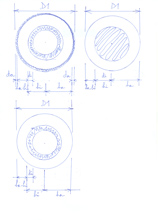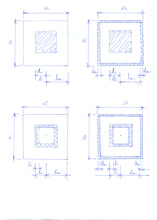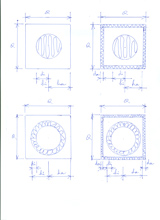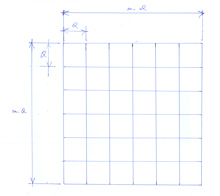In the field of silencers, new sizing possibilities for acoustics and aeraulics are offered by ITS, by the means of extended features of in-house developped software.
Recent improvements to Module 1 of the acoustics calculation software SILDIS® (reported here and there) - on methods to solve with Excel the transcendental equations in relation to sound propagation in soundproofing devices for fluids (on the one hand in the channels for fluid flow that airways are, and on the other hand in the multi-layered absorbent fillings) - potentially open up new horizons for the simulation of acoustic and aeraulic silencer performance with the software SILDIS®, thus with the advantages reported here.
Indeed, the mounting C1A (i.e. a cylindrical silencer with central splitter of diameter 2hi, with peripheral absorbent lining of thickness da and with air path ha-hi, according to this scheme, for which the calculations are now possible) is not the only configuration to which one could try to apply the calculation methodology developed (it is not nothing: taking into account finely the nature of the acoustic materials in presence and the nature as well as the thermodynamic conditions of the fluid considered).
In fact, many other configurations do not seem a priori out of reach, although (important ?) developments still need to be considered in order to progress towards the (ambitious?) goal that the prediction (with such a tool as simple, as fast and as reliable as SILDIS® is for the features already implemented in the various modules that make it up - as described here) of the acoustic and aerodynamic performance would be for all imaginable combinations, involving:
- the shape of the frontal section of the duct (round or square) and the constitution of the latter (with or without peripheral lining)
- the geometry of the frontal section of the central splitter (round or square) and the nature of the latter (hollow or not)
At this stage (for the dissipative part of the silencer, independently of the upstream and downstream connection modalities), 3 configurations, based on circular geometry for the duct (i.e. the casing) have been identified as possible: cf. figure below
|
Round silencers |
At this stage (for the dissipative part of the silencer, independently of the upstream and downstream connection modalities), 8 configurations based on a square geometry for the duct (i.e. the casing) have been identified as possible: cf. figure below
|
Silencers of square cross section, |
|
Silencers of square cross section, |
With regard to all configurations based on a square geometry for the duct (including the mounting Q0 illustrated here), it should be borne in mind that some simulation results (e.g. transmission loss), obtained for a frontal section Q2, could be extrapolated to soundproofing devices of much larger section, being of any width and height provided that multiples of Q (respectively m.Q and n.Q on the figure below), as then based on the juxtaposition of m.n elementary cells of dimension Q, the frontal section being m.n.Q2 (with or without partitioning to delimit the elementary cells of the mesh of dimension Q).
|
Silencers: juxtaposition of elementary cells, |
Thus, the continuation, by ITS, of the improvements of the software SILDIS® (silencers sizing in terms of acoustics and aeraulics) could probably allow, if completed, the dimensioning of silencers out of commercially available present ranges for various applications:
- small or medium size silencers for Heating Ventilation Air Conditioning (HVAC) installations
- silencers of (more) large size for industrial installations ; insertion conceivable not only for the exhaust of combustion turbines (namely for this latter application, limitations could incidentally exist, due to the high value of the Mach number to be considered)
Regarding silencers being out of commercially available ranges (i.e. being not off-the shelf): the marketing of such soundproofing equipment could in some cases be a competitive advantage in the context of sound insulation projects, in the building sector or in industry ?
As far as the development of silencer sizing means is concerned, the human resource of ITS (which will have devoted a significant part of its professional activity to this during past decades, as evidenced by the current possibilities offered by the SILDIS® software here, here, here and there) has already gone a long way: steps would still be needed for ITS to finalize the development of the new features of the computer program that would allow the prediction of acoustic and aeraulic performance of unconventional silencers.
For silencers being out of commercially available ranges (i.e. being not off-the-shelf), in connection with new acoustic and aeraulic sizing possibilities: ITS is looking for an industrial & commercial partner.
Knowing the potential interest of an industrial & commercial partner for all or part of the developments mentioned in this article would be useful to ITS for optimizing its software publishing activity: prioritization of actions, allocation of qualified human resources, short-term, medium and long term investments in the development of calculation functionalities for which markets opportunities would exist.
Spread the word !



